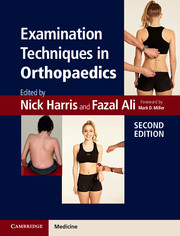Book contents
- Frontmatter
- Dedication
- Contents
- List of contributors
- Foreword
- Preface
- Acknowledgements
- 1 General principles of orthopaedic clinical examination
- 2 Examination of the shoulder
- 3 Examination of the elbow
- 4 Examination of the wrist
- 5 Examination of the hand
- 6 Examination of the peripheral nerves in the hand and upper limb
- 7 Examination of the adult spine
- 8 Examination of the hip
- 9 Examination of the knee
- 10 Examination of the foot and ankle
- 11 Examination of the brachial plexus
- 12 Orthopaedic examination techniques in children
- 13 Examination of the spine in childhood
- Index
- References
2 - Examination of the shoulder
- Frontmatter
- Dedication
- Contents
- List of contributors
- Foreword
- Preface
- Acknowledgements
- 1 General principles of orthopaedic clinical examination
- 2 Examination of the shoulder
- 3 Examination of the elbow
- 4 Examination of the wrist
- 5 Examination of the hand
- 6 Examination of the peripheral nerves in the hand and upper limb
- 7 Examination of the adult spine
- 8 Examination of the hip
- 9 Examination of the knee
- 10 Examination of the foot and ankle
- 11 Examination of the brachial plexus
- 12 Orthopaedic examination techniques in children
- 13 Examination of the spine in childhood
- Index
- References
Summary
Introduction
There is rarely a need to carry out a comprehensive examination of the shoulder including all of the tests described in this chapter. Described below are the elements that can be used to differentiate between possible diagnoses suggested by the clinical presentation. To be successful clinically and to demonstrate competence in professional examinations, interpretation of the available history is combined with an appropriately directed examination of the shoulder. Each test answers a specific question about the state and function of the components of the shoulder or the structures that enable it to work effectively. Pieced together, the clinical examination narrows down the differential diagnosis and may direct one to supplementary investigations that prove a diagnosis. Alternatively, the clinical examination may reassure that treatment can proceed without further expensive tests, pending review to confirm the expected progress. No description of clinical examination of the shoulder can therefore be complete without mention of the history that should be elicited, as this is primarily responsible for focusing the examination to those components that move one efficiently towards the correct diagnosis.
History
Patients often present with shoulders that are painful, unstable and/or stiff. Even basic demographic details are helpful, and it is important to document these for medicolegal reasons. Age, handedness and occupation should be noted. Although an open mind should be kept at all times, instability tends to dominate in the younger age group, impingement symptoms in middle age and rotator cuff tears and arthritis in the older group.
- Type
- Chapter
- Information
- Examination Techniques in Orthopaedics , pp. 7 - 24Publisher: Cambridge University PressPrint publication year: 2014
References
- 1
- Cited by



